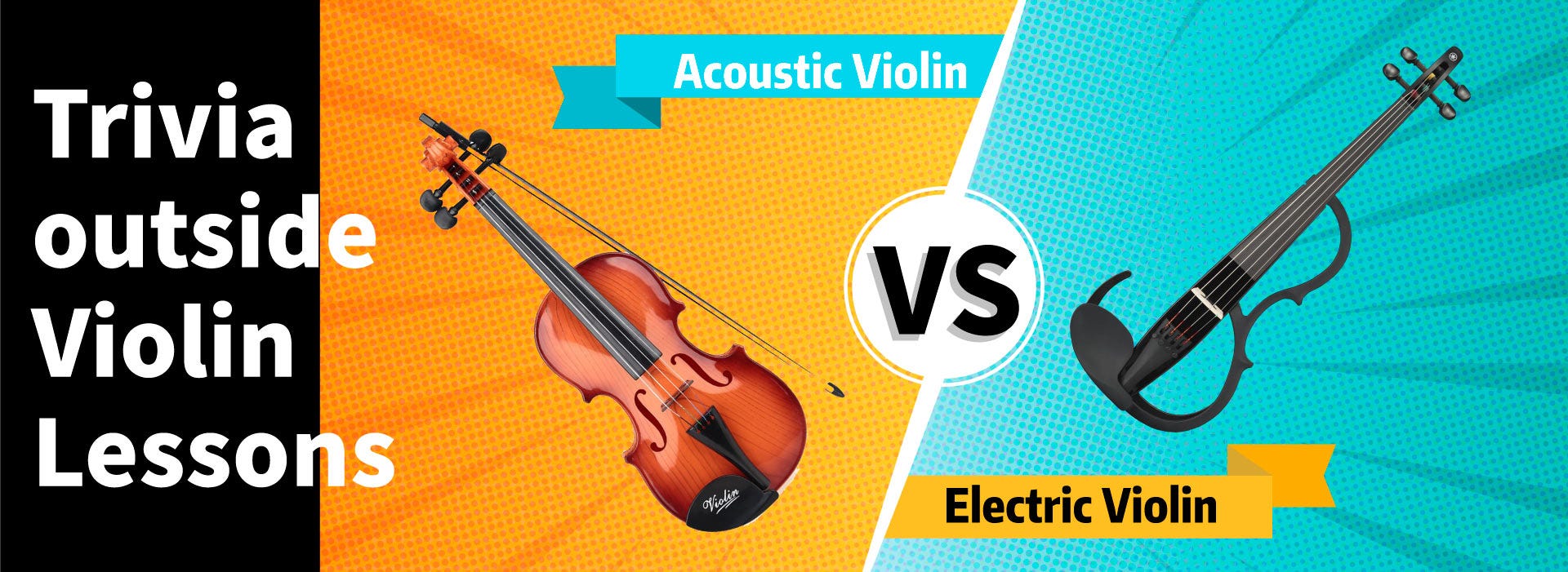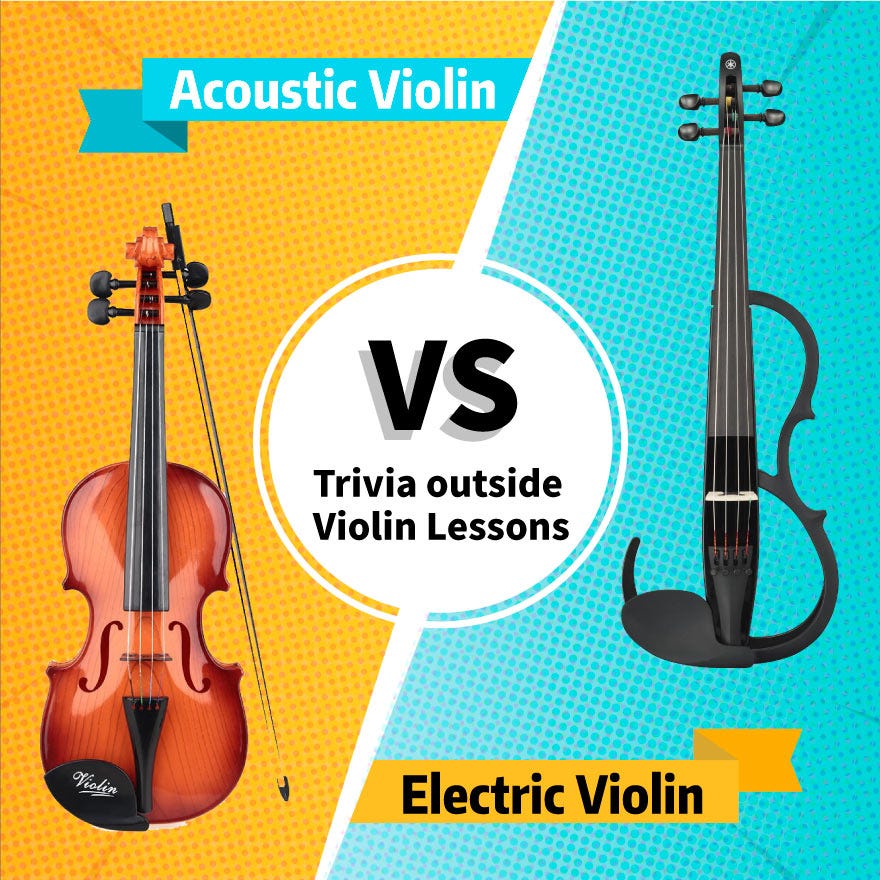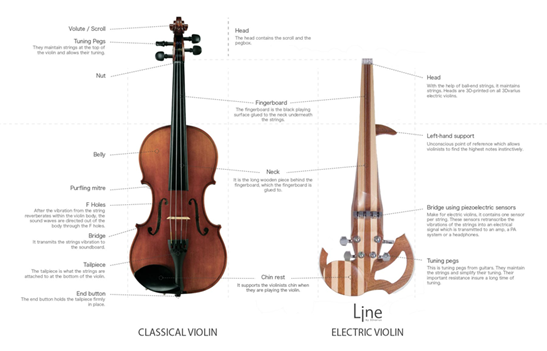Trivia outside Violin Lessons
When we talk about violin, we usually refer to the acoustic violin, or classical violin, which is widely learned and performed all over the world. As for the electric violin, some violin learners may know little about it and never try it before. On the other hand, violin teachers may not teach students to play the electric violin in violin lessons. It is obvious that electric violins are getting more popular in some occasions, such as commercial performances, stage plays, music festivals and so on. In the text below, we will discuss the differences between the acoustic violin and the electric violin.

A Brief Introduction of Electric Violin Which Is Also Used by Violin App Users
An electric violin usually refers to an instrument intentionally made to be electrified with built-in pickups, usually with a solid body. Some famous instrument stores sold electric violins in the 1930s and 1940s. Fender Musical Instruments Corporation, an American manufacturer of stringed instruments and amplifiers, produced a very small number of electric violins in 1958 and reissued them again in 1969. During the 1980s, more companies were formed producing their own brand of electric violin. There has been a great deal of commercial success for manufacturers of electric violins since the 1990s.
Violin App Users’ Opinions: Differences between Acoustic Violin and Electric Violin
Different Structures
The acoustic violin is made of a hollow structure that amplifies the vibrations of the strings. Conversely, the electric violin is often made of a solid structure and must be connected to an amplifier to be heard. Therefore, the main difference is related to the amplifying way of the sound being played.
Besides, an acoustic violin has a sound box while an electric violin does not. Therefore, an acoustic violin is heard from the moment being played. As for an electric violin, if it is not connected to an amplifier, it will not be heard by the public but produce a slight sound which is barely audible.
Different Weights
Since the acoustic violin has a hollow body, it weighs less than the electric violin. An acoustic violin weighs about 480g. The weight of an electric violin differs from one manufacturer to another. Some manufacturers may limit the amount of material and lighten the final weight of the instrument as much as possible, but others may not. Heavy electric violins may tire players’ arms and hands, and develop tendinitis in the long term.
Different Sound Transmission
An acoustic violin uses a classical bridge, which is placed on the body of the violin and sustained by the pressure of the strings. The bridge facilitates the transmission of the string vibration to the sound box. However, an electric violin will have to re-transcribe the string vibration into an electrical signal, and then transmit it to an amplifier. The “manufacture” of this electrical signal will be carried out by one or more pickups contained in the bridge. The sound quality of an electric violin will depend on the type of bridge and the number of pickups it contains. There are several types of pickups that can create the electrical signal, such as piezoelectric pickups or magnetic pickups.
Almost every violinist has already received complaints from unhappy neighbors because of the sound produced by violin exercises. Sometimes violin players may use a mute to muffle the sound of an acoustic violin, but it is not enough. Using headphones to amplify the electric violin can allow players to play quietly at home without disturbing their neighbors.
Different Designs
An acoustic violin has 4 strings: G(Sol), D(Re), A(La), E(Mi). An electric violin may have 4 or more strings. A 5-string electric violin has the C(Do) string, which is generally used on violas.
What’s more, acoustic violins always have the same visual appearances. We can find common elements on acoustic violins, such as f holes, tailpiece, scroll and so on. But these elements can disappear on an electric violin. Only some necessary elements are remained on electric violins, such as the neck and the fingerboard. In fact, electric violins can have any type of designs, colors, and materials. The certain appearance can be completely decided by the designer.

Different Sound and Genres
An electric violin does not have the same sound as an acoustic violin does. It is possible to get closer to a classical sound with an electric violin using small effects. But if violin players wanted to play classical music, they would be playing it on an acoustic violin.
A multi-effect pedal can be used on an electric violin to improve and transform the sound produced. It can transform the sound into different genres. With the effect pedals, violin players can play rock, metal, jazz, pop, etc. on an electric violin.
To conclude, acoustic violins and electric violins are designed for different uses. It is common to meet violinists who perform both kinds of violins. Moreover, most violinists have one or more copies of each instrument. They choose to use one or another depending on the playing occasions. In classical performances, such as a church ceremony, they will choose to play the acoustic violin. In other performances, like a rock music festival, they may prefer electric violin. But we recommend violin beginners to start with an acoustic violin, simply because it is much easier to play and does not require anything to be plugged in.
Have a HAPPY practice!!
More Violin Articles:
Teaching Violin Students to Read Key Signatures
Solfeges used in Violin Lessons
How to Choose Right Violin Strings
Things You Must Know About Violin Bowing
Tips for Proper Violin Maintenance
Practice Effectively after Violin Lessons
Also, check out violin sheet music on Violy App~
#ViolyPractice makes Perfect!!
Follow us on: Violy.app

